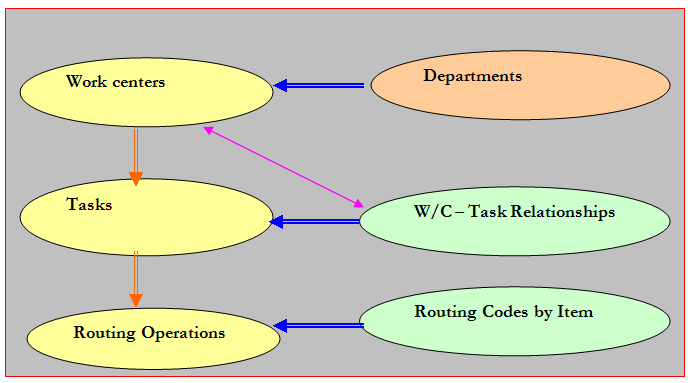Procedures for Routing in Production

Routing is the purpose of the pathway of movement of raw materials through various machines and operations from the beginning of the manufacturing process to the completion of product in its finished form. It is laying out the sequence of machines, process, and operations that are the most desirable and efficient. It is determining the exact route or path a product has to follow right from raw material till its completion.
Routing is a systematic process. The routing procedure for a new product or part may consist of the following steps:
1. Determination of what to make and what to buy
An analysis of the product is made to determine whether to manufacture a component in the factory or to purchase it from outside.
2. Determination of material requirements

Each item in the product line is divided into its components and parts required for its manufacturing. Routing section prepares a parts list which includes the drawings, specifications, standards of quality, and identification symbols of parts. Its combined with a bill of materials. This will show each part name, quantity required and the kind and amount of material required for each part. From this list, the inventory control section can determine the adequacy of the materials in stock or on order. To determine the material requirements, the “ parts short list” is also prepared. It lists only those parts which are short and hence must be obtained to complete the product.
3. Determination of manufacturing operations and their sequence
Routing section now analyses the production standards and estimates together with data on machine capacities and characteristics. From these facts, it establishes the operations necessary to manufacture the article and lists them in their proper sequence on the route sheet. The route sheet indicates for each operation its standard process time, the type of a number of machines used, materials and tools required.
4. Determination of lot sizes
Routing section also determines the number of units to be produced in any one lot. If products are made to customer's order, the lot size is generally equal to it. Where production is don to stock replacing depleted inventories, the lot size to be manufactured will usually be based on the principle of “economic lot quantities”. Where production is done on a weekly or monthly schedule, the quantity to be manufactured for the period will be based on the influx or backlog of sales orders subject to any limitations in the manufacturing capacity.
5. Determination of scrap factors

In most production processes, it is reasonable to expect some scrap. This happens because of manufacturing defects or wastage these defective pieces are called scraps. Routing section should take this scrap factor into account when determining lot size of various components parts of the final assembly, it is important to know where scrap is most likely to occur- whether it occurs progressively or all at once after a certain operation. Hence, it is necessary to establish a standard scrap factor at every stage of production. The scrap factors can be estimated on the basis of experience or scrap history.
6. Determination of the cost of the article
The routing section may also contribute to cost estimating, although it is the prime responsibility of the cost mange accounting department. Cost of the component parts and final product largely depend on the materials and manpower required for manufacturing. Direct material and labor costs are computed, and specific and general indirect expenses are allocated to the product to arrive at the cost estimate
7. Organization of production control forms
The types of production have much influence upon the forms required by the plant departments. production control is organized around schedule from in case of mass manufacturing. Job order manufacturing requires the use of a number of control forms such as job cards, shop orders, labor cards, for performing the operations. It should be remembered that production control forms in themselves are costly to use. Hence, these should be reduced to minimum consistent with the degree of control desired.
Need Help with Your Assignment?
Get expert guidance from top professionals & submit your work with confidence.
Fast • Reliable • Expert Support
Upload NowOther Assignments